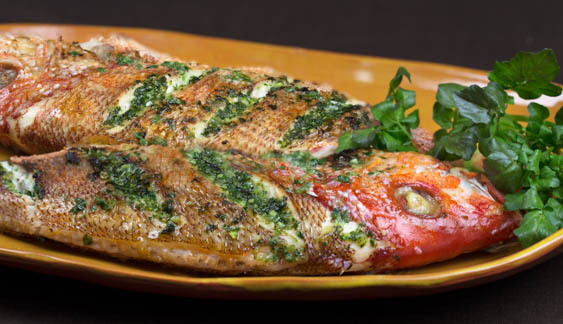Whole Roasted Snapper

introduction
What is the appeal of whole roasted fish? The possibility of a magnificent presentation, the superior succulence of the flesh itself, its crackling skin, the unmatched pleasure of discovering bits of flavor with your fingertips—in the hollows of the cheeks and other out-of-the-way interstices where tasty treasures are buried. There are also juices to consider. Nothing floods a pan like whole roasted fish, the more to mix with some Coconut Rice.
We wanted this fish to pick up, echo, and expound on flavors carried by the Coconut Rice, in whose honor this dish was created. The fish seasonings are greener and gutsier, smoothed into slashes we’ve made in its sides and whisked into a small saucepan of butter to serve at the end.
It is a flashy, company dish and stellar companion to our Caribbean Coconut-Scallion Rice.
Cooking Remarks
Make sure to have the fish gutted, scaled, and trimmed by the fishmonger. Snapper are brutal to deal with otherwise, being in possession of razor-sharp dorsal fins along their spine. Whole snappers range in size, from 1½-pounders to 4-pound behemoths. You’ll be pan-searing the fish before roasting, so opt for small ones, which are more manageable and maneuverable. Try to keep them at 1½ pounds and no larger.
The fish must be very dry and the oil fairly deep and quite hot to pan-fry successfully. Nevertheless, the fish tends to spit a bit in the pan. Lower splatter screen over the top and get out of the way!
equipment mise en place
For this recipe, you will need a sharp paring knife; a large, flat container, such as a 9 by 13-inch glass baking dish; a food processor; a small bowl; a slender rubber or small offset metal spatula; a broiler pan fitted with its slotted top (or a rimmed baking sheet fitted with a wire rack); a 12-inch heavy-bottomed skillet; a splatter screen; two wide metal spatulas; a small skillet; a whisk; and a warmed platter for serving.
-
-
2(1½-pound) whole snappers, cleaned and fins trimmed
-
1bunch scallions, trimmed and cut into fourths
-
½cup lightly packed cup fresh cilantro
-
½lightly packed cup fresh flat-leaf parsley
-
2teaspoons refined coconut oil, plus ½ cup for frying
-
1tablespoon finely grated lime zest
-
2tablespoons chopped fresh ginger
-
3medium garlic cloves, halved lengthwise and germ removed if present
-
2teaspoons fine sea salt
-
1teaspoon freshly ground black pepper
-
¼ to ½teaspoon cayenne pepper
-
4tablespoons unsalted butter
-
Lime wedges, for serving
-
Caribbean Coconut-Scallion Rice, for serving
-
-
Dry the fish well inside and out with paper towels. Holding a sharp paring knife at 45-degree angle to the fish, cut three to-the-bone diagonal slashes into each side of each fish (fig. 1.1). Place both fish in a large, flat container, such as a 9 by 13-inch glass baking dish.
-
In a food processor, combine the scallions, cilantro, parsley, 2 teaspoons coconut oil, the lime zest, ginger, garlic, salt, black pepper, and cayenne. Pulse quickly until the mixture forms a thick, bright-green paste (fig. 2.1). Measure out ½ cup of the paste into a small bowl, cover, and refrigerate for use in the sauce. With a slender rubber or small metal offset spatula, spread the remaining paste into the slashes on both sides of each fish and into the cavities (fig. 2.2), keeping the skin largely free of paste. Cover and refrigerate for 1 hour.
-
Adjust an oven rack to the middle position and heat the oven to 450 degrees. Have ready a broiler pan fitted with its slotted top (or a rimmed baking sheet fitted with a wire rack).
-
Remove the snappers from the baking dish and thoroughly pat them dry with paper towels. In a 12-inch heavy-bottomed skillet, heat ⅓ cup of the remaining coconut oil over high heat until shimmering. Very carefully lower one fish into the skillet—if the tail sticks out the skillet, don’t worry. Quickly cover with the splatter screen and fry the fish without disturbing for 20 seconds. Remove the screen and, using 2 wide metal spatulas, ease the fish onto its other side (fig. 4.1). Fry for another 20 seconds, then transfer the fish to the broiler pan.
-
Add the remaining coconut oil to the pan, heat until shimmering, and fry the second fish as you did the first, transferring it to the broiler pan next to the first. Roast until the thickest part of the fish feels firm when pressed with a finger, the flesh flakes when prodded with a knife, and spots of albumin (the egg white–like substance) are visible in the slashes, about 10 minutes (fig. 5.1). Remove the pan from the oven and let the fish rest for about 5 minutes.
-
Meanwhile, in a small skillet over medium-low heat, melt the butter. Remove the skillet from the heat, add the reserved seasoning paste, and whisk to combine (fig. 6.1).
-
Using a wide metal spatula, transfer the fish to a large warmed platter. Pour the sauce over the fish and serve with lime wedges and Caribbean Coconut-Scallion Rice. (To fillet the fish at table, begin at the head and use a sharp, thin knife, held parallel to the fish and close to the bone, to cut along the backbone to the tail. With a wide serving spatula, lift the top fillet away from the spine. Then, beginning at the tail, pull the spine away from the bottom fillet, using a knife to assist in separating the bones from the flesh. Discard the bones and allow the fillets to bathe in the sauce. Repeat this process with the second fish.)
-
-
1.1

-
-
-
2.1

-
2.2

-
-
-
4.1

-
-
-
5.1

-
-
-
6.1

-